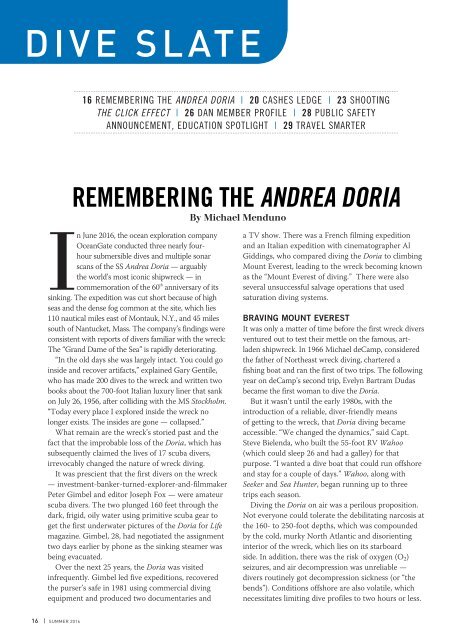AD 2016 Q3
Alert Diver is the dive industry’s leading publication. Featuring DAN’s core content of dive safety, research, education and medical information, each issue is a must-read reference, archived and shared by passionate scuba enthusiasts. In addition, Alert Diver showcases fascinating dive destinations and marine environmental topics through images from the world’s greatest underwater photographers and stories from the most experienced and eloquent dive journalists in the business.
Alert Diver is the dive industry’s leading publication. Featuring DAN’s core content of dive safety, research, education and medical information, each issue is a must-read reference, archived and shared by passionate scuba enthusiasts. In addition, Alert Diver showcases fascinating dive destinations and marine environmental topics through images from the world’s greatest underwater photographers and stories from the most experienced and eloquent dive journalists in the business.
You also want an ePaper? Increase the reach of your titles
YUMPU automatically turns print PDFs into web optimized ePapers that Google loves.
DIVE SLATE<br />
16 REMEMBERING THE ANDREA DORIA | 20 CASHES LEDGE | 23 SHOOTING<br />
THE CLICK EFFECT | 26 DAN MEMBER PROFILE | 28 PUBLIC SAFETY<br />
ANNOUNCEMENT, EDUCATION SPOTLIGHT | 29 TRAVEL SMARTER<br />
REMEMBERING THE ANDREA DORIA<br />
By Michael Menduno<br />
In June <strong>2016</strong>, the ocean exploration company<br />
OceanGate conducted three nearly fourhour<br />
submersible dives and multiple sonar<br />
scans of the SS Andrea Doria — arguably<br />
the world’s most iconic shipwreck — in<br />
commemoration of the 60 th anniversary of its<br />
sinking. The expedition was cut short because of high<br />
seas and the dense fog common at the site, which lies<br />
110 nautical miles east of Montauk, N.Y., and 45 miles<br />
south of Nantucket, Mass. The company’s findings were<br />
consistent with reports of divers familiar with the wreck:<br />
The “Grand Dame of the Sea” is rapidly deteriorating.<br />
“In the old days she was largely intact. You could go<br />
inside and recover artifacts,” explained Gary Gentile,<br />
who has made 200 dives to the wreck and written two<br />
books about the 700-foot Italian luxury liner that sank<br />
on July 26, 1956, after colliding with the MS Stockholm.<br />
“Today every place I explored inside the wreck no<br />
longer exists. The insides are gone — collapsed.”<br />
What remain are the wreck’s storied past and the<br />
fact that the improbable loss of the Doria, which has<br />
subsequently claimed the lives of 17 scuba divers,<br />
irrevocably changed the nature of wreck diving.<br />
It was prescient that the first divers on the wreck<br />
— investment-banker-turned-explorer-and-filmmaker<br />
Peter Gimbel and editor Joseph Fox — were amateur<br />
scuba divers. The two plunged 160 feet through the<br />
dark, frigid, oily water using primitive scuba gear to<br />
get the first underwater pictures of the Doria for Life<br />
magazine. Gimbel, 28, had negotiated the assignment<br />
two days earlier by phone as the sinking steamer was<br />
being evacuated.<br />
Over the next 25 years, the Doria was visited<br />
infrequently. Gimbel led five expeditions, recovered<br />
the purser’s safe in 1981 using commercial diving<br />
equipment and produced two documentaries and<br />
a TV show. There was a French filming expedition<br />
and an Italian expedition with cinematographer Al<br />
Giddings, who compared diving the Doria to climbing<br />
Mount Everest, leading to the wreck becoming known<br />
as the “Mount Everest of diving.” There were also<br />
several unsuccessful salvage operations that used<br />
saturation diving systems.<br />
BRAVING MOUNT EVEREST<br />
It was only a matter of time before the first wreck divers<br />
ventured out to test their mettle on the famous, artladen<br />
shipwreck. In 1966 Michael deCamp, considered<br />
the father of Northeast wreck diving, chartered a<br />
fishing boat and ran the first of two trips. The following<br />
year on deCamp’s second trip, Evelyn Bartram Dudas<br />
became the first woman to dive the Doria.<br />
But it wasn’t until the early 1980s, with the<br />
introduction of a reliable, diver-friendly means<br />
of getting to the wreck, that Doria diving became<br />
accessible. “We changed the dynamics,” said Capt.<br />
Steve Bielenda, who built the 55-foot RV Wahoo<br />
(which could sleep 26 and had a galley) for that<br />
purpose. “I wanted a dive boat that could run offshore<br />
and stay for a couple of days.” Wahoo, along with<br />
Seeker and Sea Hunter, began running up to three<br />
trips each season.<br />
Diving the Doria on air was a perilous proposition.<br />
Not everyone could tolerate the debilitating narcosis at<br />
the 160- to 250-foot depths, which was compounded<br />
by the cold, murky North Atlantic and disorienting<br />
interior of the wreck, which lies on its starboard<br />
side. In addition, there was the risk of oxygen (O 2 )<br />
seizures, and air decompression was unreliable —<br />
divers routinely got decompression sickness (or “the<br />
bends”). Conditions offshore are also volatile, which<br />
necessitates limiting dive profiles to two hours or less.<br />
16 | SUMMER <strong>2016</strong>









